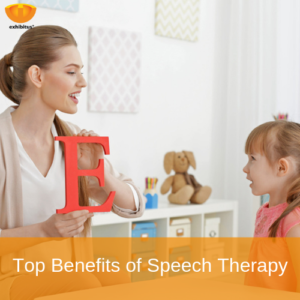5 Ways Speech Therapy Helps Children with Autism
Speech therapy is often the first recommendation for children diagnosed with autism. That is because communication impairments are common and the most prevalent indicator in children with Autism.
Autism is a developmental disability that varies in severity, with a patient’s diagnosis falling somewhere on the Autism Spectrum Disorder (ASD). The spectrum ranges from pervasive developmental disorder to the less severe Asperger’s Syndrome. Patients may have impaired communication, social interaction, or cognitive skills.

Speech-language pathologists (SLP) can help people with ASD by modifying social communication and behaviors to increase social acceptance. SLPs collaborate with other professionals or the patient’s loved ones to provide better care, as well as design and implement tailored treatment plans.
Following is a list of ways an SLP can help children with autism become socially aware and perform basic tasks. It is important to mention that no single method is a guaranteed way to help every child with Autism, as everyone is different and their challenges may vary.
1. Picture Boards With Words For Speech Therapy
One of the best ways of communicating with children with Autism is to use visual support. This type of exercise provides structure to words. There are several ways to use visual support to enhance communication with patients with Autism. For example, picture boards help connect objects and the Picture Exchange Communication System (PECS) to communicate a request.
Picture Boards
The use of picture boards by SLPs, parents, or friends can help children learn symbols and photos and associate words to them. The child points to an object on the picture board to communicate to the caregiver what they need. This promotes their social skills, encourages them to ask for whatever they need, and teaches them how to improvise if the object they need isn’t on the board.
PECS
In the Picture Exchange Communication System, SLPs teach children to approach another person and exchange a picture of the desired item for that item. For example, a parent can give the child a glass of water for its picture.
Developed in 1984 by Lori Frost, PECS was first used at the Delaware Autistic Program. PECS has 6 phases:
- How to communicate
- Distance and persistence
- Picture discrimination
- Sentence structure
- Answering questions
- Commenting
2. Singing Songs To Create Rhythm In Sentences
Children with Autism are more likely to respond to music than to speech. Studies have revealed that they are quicker at recalling music than words. This is because they are able to find connections to the repetitive melody, making them more responsive. The constant repetition creates a rhythm – something the child gets attached to.
The rhythm provided by music is also reflected in autistic children who are able to talk as they communicate that rhythm in their speech. This association increases their cognitive ability, and in turn, lets them structure better sentences.
3. Massaging Facial Muscles For Improved Speech
Massaging any muscle can provide relaxation and reduce stress. As they get accustomed to physical touch, massaging facial muscles can help children with Autism relax and promote social relatedness behavior. The touch will also help increase attention span and reduce withdrawal or touch aversion. The child might not be able to say “yes” or “thank you” during facial massage, so attention to their reaction is critical. If they aren’t recoiling from touch, know that he or she is making progress.
However, facial massage should be carefully approached. Unexpected contact may scare the child and make them react adversely. The SLP should start out by making the child feel comfortable with touch, and give them the opportunity to participate in the session.
4. Articulate Words Better With Practice
When teaching words to your child, keep in mind to articulate them more clearly than you normally do. The clearer you say it, the better they’ll understand, retain, and imitate it. When teaching the child new sounds, make sure you give them different variants of the word. While they may pronounce the sound properly on its own, they might not be able to say it properly mid-word. Give them clear feedback when they do something good or bad.
5. Exercises
Once autism is diagnosed, speech therapists analyze the needs of the child to give them the best possible care and quality of life. Speech therapists can help by providing electronic talkers or teaching them to sign and type.
SLPs can give lip and facial exercises to improve oral motor function. The enhanced movement of the tongue, lips, and jaw make it easier for them to talk.
Parents can review a lengthy list of indicators to determine if their child has ASD, the most prevalent of them being:
- Learning disability
- Unresponsiveness to familiar sounds or their name
- Unable to follow objects with eyes
- No response to cuddling or being picked up
- No big smiles or joyful expressions
- No back-and-forth sharing or sounds or expressions
- No baby talk
If this is the case with your baby, consider getting the appropriate help for a proper diagnosis. Then, give us a call. At PT Solutions, we’d love to provide speech therapy to your child. Click here to schedule an appointment or find a clinic near you.